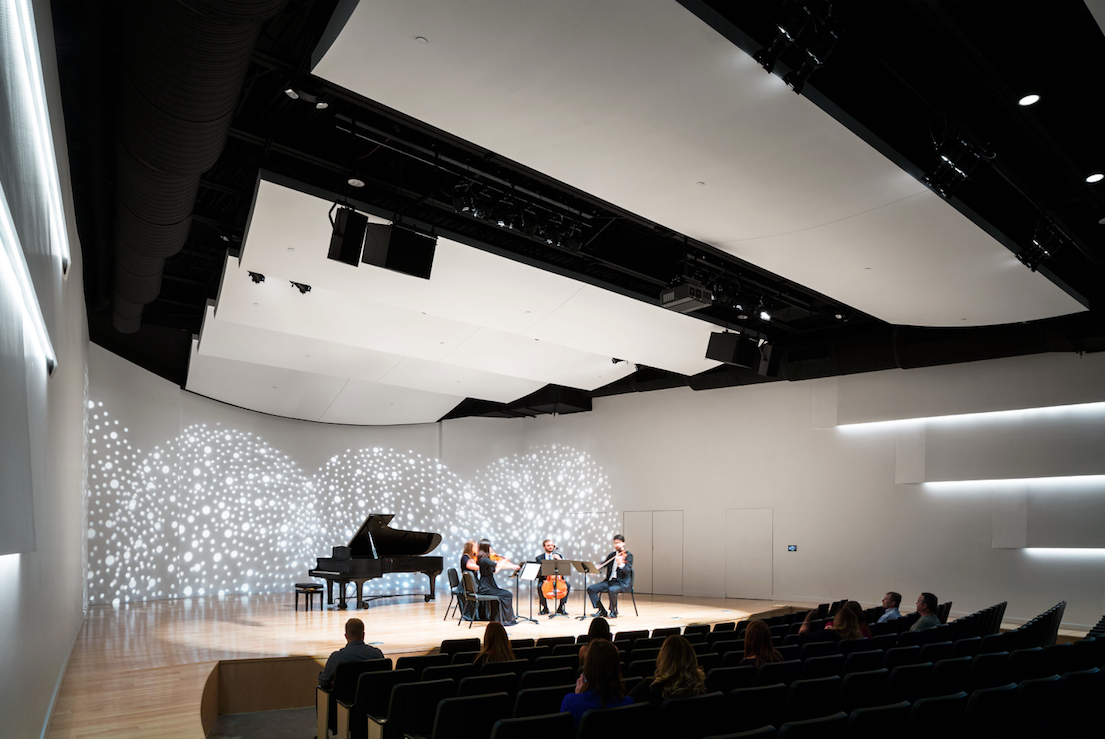A couple of years ago, Ruth Meints, Executive Director of the Omaha Conservatory of Music, got a notice from the organization’s landlord that the conservatory would have to vacate its space in a local community center by January 2016. Meints, who also teaches violin and viola at the OCM, wasn’t crazy about the space to begin with—it was small and had acoustical problems—but it was home. What to do?
Luckily, Meints happened to be in touch with David Lempke, HDR’s Vice President and Design Principal, and Lempke happened to be aware that Temple Israel had built a new facility in town, which freed up its old building as a possible home for the conservatory.
The old temple, built in 1952, was in decent shape, Lempke recalls. The conference room, administrative offices, and classrooms could be reprogrammed relatively easily for the conservatory’s needs for studios and teaching spaces. But the windows and roof needed to be replaced. Many of the walls lacked insulation or vapor barriers. The HVAC system had no humidity control—essential to protect the musical instruments—and would have to be replaced.
After $15 million in reconstruction, the new 40,000-sf conservatory opened in late 2015, well ahead of the deadline. The sanctuary, with its sloping floors and sidewalls, was converted to a shoebox-shaped performance center with a 48-foot-wide stage. Irwin Seating Company installed telescopic seats whose backs and bottoms fold up and retract, bleacher-style, into the back wall. This more than doubled the seating capacity to 500.
These days, Meints can lead her Violin Sprouts - the program she pioneered in 2013 for young musicians - under much improved conditions.
 After a devastating fire, Congregation Kehilath Jeshurum in New York reconsidered how to expand its sanctuary (pictured in its rebuilt state) and its school. Image: Chris Cooper.
After a devastating fire, Congregation Kehilath Jeshurum in New York reconsidered how to expand its sanctuary (pictured in its rebuilt state) and its school. Image: Chris Cooper.
OUT OF THE ASHES
Five years ago, FXFowle Architects was overseeing the renovation of Congregation Kehilath Jeshurun’s synagogue, in the Upper East Side of New York City, when the roof went up in flames. The fire severely damaged the century-old sanctuary but spared the lower school and the limestone neo-Classical façade. The fire prompted the institution to reconsider how to grow its facilities to meet the needs of its congregation and students.
Ann Rolland, FAIA, Principal with FXFowle, says that her firm recommended moving the 1,150-student school and gym to higher floors, which would more clearly delineate the functions of the building along its horizontal and vertical axes. That move required erecting a complicated structural system to support the two-story addition and relieve pressure on the synagogue’s walls during construction.
FXFowle brought the 18,000-sf sanctuary up to code. Italian crafts workers, using traditional methods, recreated columns, egg-and-dart molding, and new scagliola finishes on the main ark and new column enclosures. The steel reinforcement within the sanctuary had to be positioned to minimize seating loss for congregants.
This 80,000-sf project, which was completed in the summer of 2015, came in on budget at $40 million, says Rolland. ZDG LLC was the cost estimator; project management firm VVA was owner’s representative.
The synagogue’s worst fear—that its congregation would drift away during the reconstruction—proved to be unfounded. “This project was about rebuilding and revitalizing a community,” says Rolland.
Related Stories
| Jun 12, 2014
Austrian university develops 'inflatable' concrete dome method
Constructing a concrete dome is a costly process, but this may change soon. A team from the Vienna University of Technology has developed a method that allows concrete domes to form with the use of air and steel cables instead of expensive, timber supporting structures.
| Jun 9, 2014
Green Building Initiative launches Green Globes for Sustainable Interiors program
The new program focuses exclusively on the sustainable design and construction of interior spaces in nonresidential buildings and can be pursued by both building owners and individual lessees of commercial spaces.
| May 29, 2014
7 cost-effective ways to make U.S. infrastructure more resilient
Moving critical elements to higher ground and designing for longer lifespans are just some of the ways cities and governments can make infrastructure more resilient to natural disasters and climate change, writes Richard Cavallaro, President of Skanska USA Civil.
| May 20, 2014
Kinetic Architecture: New book explores innovations in active façades
The book, co-authored by Arup's Russell Fortmeyer, illustrates the various ways architects, consultants, and engineers approach energy and comfort by manipulating air, water, and light through the layers of passive and active building envelope systems.
| May 19, 2014
What can architects learn from nature’s 3.8 billion years of experience?
In a new report, HOK and Biomimicry 3.8 partnered to study how lessons from the temperate broadleaf forest biome, which houses many of the world’s largest population centers, can inform the design of the built environment.
| May 13, 2014
19 industry groups team to promote resilient planning and building materials
The industry associations, with more than 700,000 members generating almost $1 trillion in GDP, have issued a joint statement on resilience, pushing design and building solutions for disaster mitigation.
| May 11, 2014
Final call for entries: 2014 Giants 300 survey
BD+C's 2014 Giants 300 survey forms are due Wednesday, May 21. Survey results will be published in our July 2014 issue. The annual Giants 300 Report ranks the top AEC firms in commercial construction, by revenue.
| May 2, 2014
World's largest outdoor chandelier tops reworked streetscape for Cleveland's PlayhouseSquare
Streetscape project includes monumental gateway portals, LED signage, and a new plaza, fire pit, sidewalk café, and alfresco dining area.
| Apr 29, 2014
USGBC launches real-time green building data dashboard
The online data visualization resource highlights green building data for each state and Washington, D.C.
| Apr 16, 2014
Upgrading windows: repair, refurbish, or retrofit [AIA course]
Building Teams must focus on a number of key decisions in order to arrive at the optimal solution: repair the windows in place, remove and refurbish them, or opt for full replacement.
















